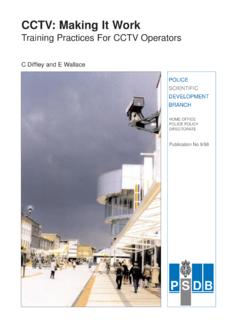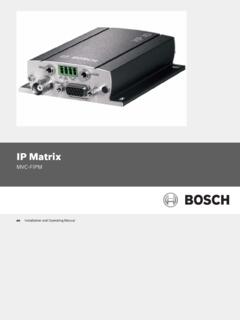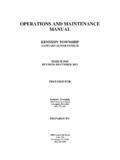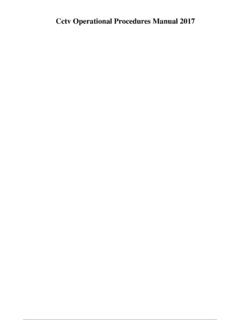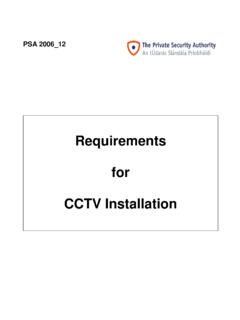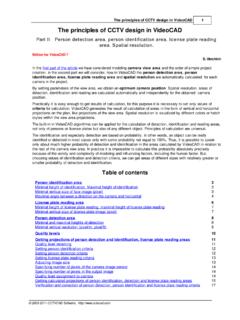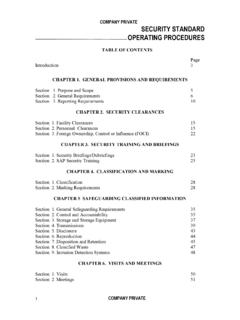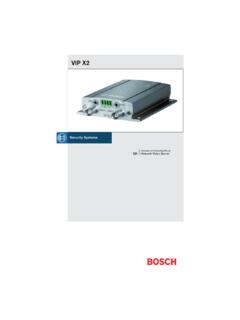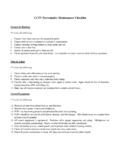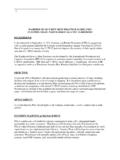Transcription of MINIMUM REQUIREMENTS FOR VIDEO SURVEILLANCE …
1 MINIMUM REQUIREMENTS . FOR VIDEO SURVEILLANCE SYSTEM FOR PUBLIC AREAS. K stutis Gra elis, Dainius Barkauskas1. Pavel Laptev, Kristi Targamaa2. Mareks Smilga3. Introduction cctv VIDEO footage is a great source of evidence for courts and law enforcement agencies all around the world. With the fundamental shift from analogue to digital SURVEILLANCE systems, the amount of cctv VIDEO footage that is used in courtrooms in the form of the evidence has rapidly increased. A cctv system is expensive to implement, manage and maintain. If it is installed incorrectly or maintenance procedures are not put into place, the entire cctv solution can be very ineffective in providing enough information about a security incident that may occur on your premises. The evidential value of cctv footage directly depends on its visual quality, integrity and the authenticity of the original VIDEO files.
2 The evidential value of cctv footage also depends on the procedures used for the gathering and handling of the image material retrieved from the cctv system. Bad equipment selection, mistakes in system setup and irregular maintenance can reduce the overall performance of many cctv systems. As a result, at the time of a crime being committed, a cctv . system may not be able to capture the VIDEO with best possible quality. Later on, law enforcement officials cannot retrieve valuable information from the footage that could help them identify any suspects, restore the chain of events or quickly resolve the crime. Very often, the suspect denies his involvement in the crime and the collected cctv footage cannot provide enough details that represent any distinctive features of the suspect (facial features, tattoos, clothing, type of vehicle, license number plate, etc.)
3 Insufficient training of the staff can also lead to mistakes in the handling and retrieval of cctv . footage, resulting in damaged VIDEO material, a reduction in its original quality or the integrity of the VIDEO material being compromised. The purpose of this document is to specify the major aspects that may affect the visual quality of cctv footage and its performance in effectively recording VIDEO . 1. operational Guidance 1. Department of forensic examinations of Digital Information of Forensic Science Centre of Lithuania, Lvovo str. 19A, Vilnius, Lithuania, phone +3705 2638561. 2. Forensic IT-Department of Estonian Forensic Science Institute, Tervise 30, Tallinn 13419, Estonia, phone +372 6636600. 3. State Forensic Science Bureau, Upes street -1a, Riga LV-1013, Latvia, phone ++371 67374010.
4 Main purposes of SURVEILLANCE : Safety/security cctv provides an aid to the security and safety of your establishment. Deterrence a cctv system can deter potential criminals and it can be used for crime prevention. Crime investigation the content of the image material can be examined by law enforcement officials. Reduction in insurance costs a cctv system installation can be requested by an insurance company;. There are some issues that should be taken into account before purchasing a cctv SURVEILLANCE system: There are no post-production techniques that can significantly improve the initial quality of cctv footage that has been captured. The initial quality must be in accordance with the aim of observation. Often, it is not possible to cover all the security aspects (wide-angle and close-up images) with one SURVEILLANCE camera or several cameras of the same range.
5 Good coverage of the premises using different types of cameras with different lenses can offer multiple chances to record a suspect on camera. There are no proper industry standards concerning the resolution, recorded media format, frame rate, data and file formats. Most cctv system manufacturers don't even adhere to an AVI standard, or an agreed to specification for the DVR hardware and software, file formats, compression and encoding. There are now thousands of poorly documented or undocumented DVR systems. There are plenty of unbranded low-cost DVR systems on the market now that cannot provide any customer support and may contain faulty hardware or firmware. Check online for some customer reviews before purchasing unknown or unbranded DVR systems. The effective use of a cctv system is not possible without properly planned operational management, detailed documentation and sufficient training of the personnel using it, especially regarding system control and the retrieval and extraction of the recorded VIDEO files.
6 The legal laws and operational and security procedures that protect the integrity of digital evidence and its authenticity should be followed at all times. Observational Purposes Before the purchase and installation of a system, it is crucial to specify the purpose of the observation (what should be seen, when and where?). Will the camera be viewing a wide area fairly close to the camera? Will images from a narrow area or far away be important? What are the lighting conditions, and will they change? There are several security purposes that a cctv system may serve: a) Monitoring your territory and detecting the movement of people or vehicles: It may be suitable for covering a wide area such as a car park to watch the flow of traffic, or the movement of people where you do not need to pick out individual figures or detect the presence of a person in the image without needing to see their face.
7 The figure of a person or a car moving in the area should occupy 5 10% of the screen height. The observer has to be able to see the figures of people in variable weather and lighting conditions. Cameras used for the purposes of monitoring and detecting movement can be used in wide areas where you do not expect to capture any reasonable detail of the moving subjects or their actions. Figure 1. person occupies 5-10% of the screen height Outdoor cameras usually serve for the purposes of monitoring and detecting. For this reason, the selection of an appropriate camera that can work in variable weather and lighting conditions with protection against damage or vandalism is crucial. It will be well worth the time involved in choosing an appropriate lens for your Monitor/Detect cameras in order to achieve the sustainable visual quality of your VIDEO recordings.
8 (see technical guidance for varifocal and auto-iris lenses). b) Observing the events happening in your territory: This is useful in areas where it is necessary to monitor a group of individuals such as outside nightclubs and pubs, streets in a town centre, aisles and stock rooms in shops, car parking and other places where the reasonable detail of the subject (person or car) is needed with some context to their activity by monitoring the area around them. If a still camera is used for this purpose, the figure of a person or a car moving in the area should occupy 25 40% of the screen height: Figure 2. A person occupies 25 - 40% of the screen For outdoor cameras, the observer has to be able to see some characteristic details of the individual or vehicle (such as clothing, type or model of the vehicle and probably some other distinctive details).
9 For indoor cameras, the lighting and camera focus should be adequate to capture clear images both day and night. If you are using security staff for monitoring purposes, Pan-Tilt-Zoom (PTZ) cameras that are capable of remote directional and zoom control can be used as an option. c) Recognising people or vehicles involved in some event: You should be able to say with a high degree of certainty whether or not an individual shown is the same as someone seen before, recognise somebody you know, or determine that somebody is not known to you. If a still camera is used for person recognition purposes, the figure of a person should occupy at least 50% of the screen height. The characteristic features of the person (clothing, posture, objects being carried) or a vehicle (make, model, colour) have to be seen.
10 cctv frames with such a level of detail usually allow law enforcement officials to capture the major distinctive features of the suspect and identify him, or determine if the person seen on the footage was involved in other crimes in the area. One of the distinctive features of a person is his or her height. If there is a risk of masked robbery, it is essential to be able to measure the height of the suspect using frames from your cctv . The measurement of a suspect's height is essential, in that the entire figure of the suspect from their feet to the top of their head can be seen at some point of the suspect's movement with part of the floor they are standing on. d) Identifying people involved in some event: In this case, it is necessary to be able to identify an individual in such a way that it can be established beyond a reasonable doubt, and to record high quality facial images that can be used in a court to prove someone's identity beyond a reasonable doubt.
